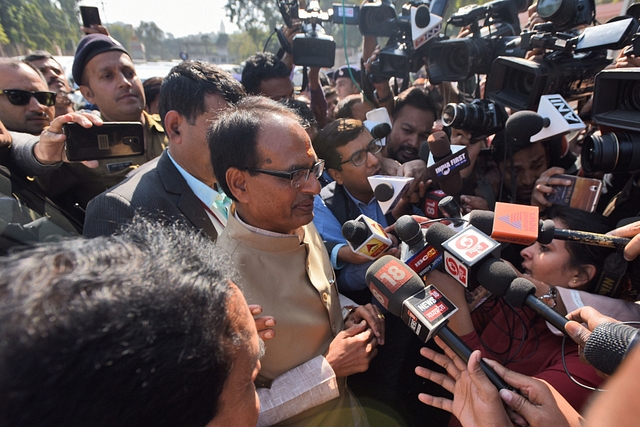
Was Rural Distress One Of The Key Reasons For BJP’s Loss In Three States? Data Says Otherwise
Rural distress alone was not responsible for BJP’s inability to form government in the three states. A host of state/national level and hyper local issues determined the results.
The Indian National Congress has formed government in the three Hindi heartland states which went to polls recently. The 3-0 verdict has led political commentators and analysts to believe that this is all attributable to rural distress brought about by demonetisation. After all:
Bharatiya Janata Party’s (BJP’s) rural tally declined by 31 per cent in Madhya Pradesh, 57 per cent in Rajasthan and 68 per cent in Chhattisgarh
- Overall, BJP tally in these three states reduced by half on rural seats in 2018 compared to 2013.
Tables like the one given below are being used to drive home the point.
Elections, however, are not won or lost on a single factor but a host of them and a complex interplay amongst them.
- In MP, key factors were local anti-incumbency against sitting MLAs, voter fatigue with BJP, freebies, impact of Scheduled Caste/Scheduled Tribe (Prevention of) Atrocities Act
- In Rajasthan, key factors were similar, plus a strong trend of people believing change is better for development, favoured the Congress.
- In Chhattisgarh, people yearning for badlav, corruption, tribal rights, the Ajit Jogi factor, Chhattisgarhi asmita, etc, all played a key role in elections.
To say rural distress as one of the key reasons for BJP's loss is making too simplistic an assumption without looking at the data properly. If there was truly rural distress, Congress wouldn’t have fallen short of a majority in MP and Rajasthan, which are primarily rural states. MP has 183 rural seats out of 230, Rajasthan has 162 out of 200. After 15 years of anti-incumbency in MP and Chhattisgarh, and strong trend of overthrowing incumbent in Rajasthan, along with rural distress as is being claimed, Congress should have swept all the states and not only Chhattisgarh. If there was rural distress how is BJP retaining rural seats. Not only retaining but it is gaining seats from the Congress. How is it possible? Let’s look at the data below:
Madhya Pradesh
If one looks closely at Madhya Pradesh rural data:
- 54 seats have been retained, 68 lost and 30 gained by BJP
- 44 per cent of 2013 rural tally has been retained by BJP, this is impossible in rural stress scenario
- 36 per cent of BJP’s 2018 tally represents seats wrested from Congress (is this rural distress?)
- Congress lost half of its 2013 rural seats (28 out of 56), how come?
Rajasthan
Similarly, if one looks closely at Rajasthan rural data:
- 49 retains, 82 losses and seven gains for BJP
- 37 per cent of rural tally of 2013 has been retained by BJP despite so-called rural distress
- of the new rural seats 13 per cent are gains for BJP
- Additionally, 2013 verdict was an aberration and percentage gains/losses (on a high base) don’t necessarily show the true picture
Chhattisgarh
Similarly, if one looks closely at Chhattisgarh data:
- Six retains, 35 losses and seven gains for BJP
- of the new seats 50 per cent are gains, this is not possible in rural distress scenarios.
Vote Shares Are Even Stevens
In terms of vote shares, there is not much to choose between the BJP and Congress in rural Madhya Pradesh. Both are almost tied with Congress at 40.5 per cent and BJP at 39.5 per cent. In Rajasthan, BJP recorded 38 per cent and Congress 39 per cent vote share in rural seats. In Chhattisgarh, the gap is higher because of the historic mandate, BJP 32 per cent and Congress 42 per cent.
SC-ST Atrocities Act Impact
Out of the total rural seats in the three states, 40 per cent are reserved for SC-ST category, MP 42 per cent, Rajasthan 34 per cent and Chhattisgarh 50 per cent. We have seen how the Dalits and Tribals have voted against BJP across these three states in these elections and it’s not only due to rural distress. In MP, Congress party’s alliance with JAYS helped the party in tribal seats. In Rajasthan, the Kirori Lal Meena factor didn’t work in the ST reserved seats. In Chhattisgarh, Ajit Jogi and Mayawati dented BJP more instead of Congress in ST and SC seats respectively. BJP lost 141 rural seats in these three states and more than half are accounted for by reserved seats.
- in MP 77 out of 183 rural seats are SC-ST, BJP had won 53 in 2013 reduced to 24 in 2018
- in Rajasthan, 55 out of 162 rural seats are SC-ST, BJP had won 46 in 2013 reduced to 16 in 2018
- in CG, 39 out of 78 rural seats are SC-ST, BJP had won 20 in 2013, down to 5
To sum up, rural distress alone is not responsible for BJP’s inability to form government in the three states. Host of state/national level and hyper local issues determined results on each seat, and these varied from seat to seat as well as data indications.